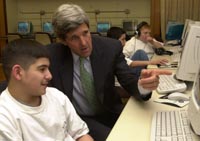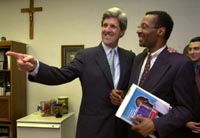BOSTON, Feb. 25, 2002 — When Paulo Oliveira was 10 and enrolled at the Salesian Boys & Girls Club (B & GC) located in the East Boston neighborhood, he had no idea that seven years later he would play a role in preparing a state-of-the-art computer lab for the club. Oliveira was a key figure in getting the lab up and running; he set up the hardware, made sure the software worked properly, checked that the machines were networked and confirmed that access to the Internet was available. Now a senior in high school, Oliveira works at the Salesian B & GC three or four days a week.

U.S. Senator John Kerry of Massachusetts and Salesian Boys & Girls Club students take the new “Club Tech” software for a spin. Click on photo for high-resolution image
“As a staff member now, I can see what opportunities are available for the kids, what they can do,” Oliveira says. “It’s great for the kids with fewer opportunities — they just need the chance to show off what they can do.”
Microsoft agrees, which is why in Dec. 2000, Microsoft and Boys & Girls Clubs of America (B & GCA) announced the Club Tech initiative to “technology enable” Clubs across the country. The program is funded by a US$100 million cash and software donation from Microsoft, and will, over the five-year life of the initiative, establish technology centers, computing activities and curriculum, as well as program management and computer training for staff.
More than 390 Club Techs are up and running across the U.S., with more than 600 targeted for launch within the next six to eight months. Approximately 3.5 million children stand to benefit from the program. Today, Microsoft and B & GCA announced the rollout of the Club Tech program throughout the greater Boston area — with the addition of 16 new Club Techs.
“The goal of the program is to provide meaningful access to technology and provide kids the opportunity to use technology as a tool to expand their world and their opportunities,” says Bruce Brooks, director of Community Affairs at Microsoft. “Through our partnership with the Boys & Girls Clubs of America, our hope is to integrate technology into all aspects of club activity so that club members will gain technology skills, knowledge and interest that will help them realize their full potential in the future.”

Sen. Kerry (left) thanks Microsoft Community Affairs Director Bruce Brooks at the opening of the newest Club Tech. Click on photo for high-resolution image
One of several Boston-area clubs, all of which work independently, the Salesian B & GC primarily works with disadvantaged youth. Its members come from a wide variety of ethnic backgrounds — 40 percent Hispanic; 35 percent Caucasian or African American and 25 percent Asian American.
“There is a difference between upper-middle-class kids who have access to nice computers at their schools or libraries or their homes, and the kids that we deal with, whose only access to computers and this kind of technology is at the club,” explains Rev. Richard Crager, executive director of the Salesian B & GC. “Jobs in the future are going to depend on their ability to master these instruments, and we don’t want to shortchange our kids — we want to at least give them a level playing field.”
The Salesian B & GC has 1,600 members, but Crager estimates that of those, 500-600 attend regularly — at least once a week. Others might only participate in summer or winter camp programs. A $10 annual membership fee is waived if a family cannot afford to pay. The fee, Crager explains, “helps members feel that they’ve really bought into the club; that it’s really theirs and they can use it like it’s theirs.” The club serves ages 6-18, but use of the computers is restricted to age 8 and above.
Members sign up by the hour to use one of 25 computers in the lab, which are monitored and maintained by one full-time staff member and two part-time assistants — including Oliveira, who will earn a Cisco networking certification at the end of the school year from his technical vocational high school.
Crager has observed a noticeable increase in club attendance since the technology lab opened. As executive director of a B & GC in Ohio, Crager had previously established a 30-station computer lab. “I just saw what it did — it really brought up the number of kids and what kids were able to do and I knew we had to have that here,” he says.
One of his goals is to reach older club members. “We’re working on getting higher-end technology that we don’t have in place yet,” Crager says. “We want to reach those older teenagers and really get them involved in things like the graphic arts — video editing, digital photography. We have three digital cameras now, and six on order.”
Each computer in the lab runs on Microsoft Windows 2000 Professional, soon to be upgraded to Windows XP Professional. In addition, the computers are outfitted with Office XP Professional, Front Page 2002, Publisher 2002, Picture It! Premium Edition 2002, Encarta Reference Library 2002, Streets and Trips 2002, Magic School Bus and Creative Writer 2.0.
“I can do basic things on a computer, but I’ve seen kids make their own Web pages,” says Gerald Carino, Salesian B & GC program director. “They just keep teaching each other. It just amazes me.”
Crager would like to implement a program that will teach the kids to touch type, but currently, they already use the computers to accomplish a variety of tasks — not only do they create their own Web pages, but they also do their homework; conduct research on the Internet; e-mail; play games; chat with their friends.
One such youth is Carlos Mena, 13, a middle-school student who has been attending the Salesian B & GC since he was 6. “When I heard about the computer lab, I thought, ‘This is really cool,'” he says. “Now I can use programs that I wouldn’t think I could use, like Microsoft Word. I can do my homework on it, and since we have Internet Explorer, I can do my research on social studies, and then just type it up.”
Mena says he visits daily after school, spending as many as four hours visiting with his friends and playing sports such as dodgeball, football and baseball. But the Club Tech program has made the Salesian B & GC much more than a “swim ‘n gym.” Most of Mena’s time is spent doing his homework in the computer lab. “It’s like a camp where you can learn a lot of things,” he says. “My parents — and me, too — think it’s a good place because it’s a cool hang out spot, and you can’t get into trouble.”
The Club Tech program helps kids like Mena realize their potential, Crager says, by providing access to technology and the Internet, which exposes them to a world they might never have known otherwise. “Many of these kids are economically deprived, and using the Internet, they can see a lot of things that they ordinarily wouldn’t get a chance to see,” he says. “But now they know that they’ve got access to some of the best technology that’s around for anyone, so they don’t have to feel that they’re taking second place to anybody no matter what their economic circumstances might be. They see they have the tools, and it’s what they do with these tools that’s going to make a difference in their lives.”
“Some of the kids can’t stop looking and learning, clicking on this and that to see what everything does,” Oliveira says. “I was like that, and now I have the opportunity to work here. I tell them that they can do the same thing that I did — and maybe get a job at Microsoft one day.”




